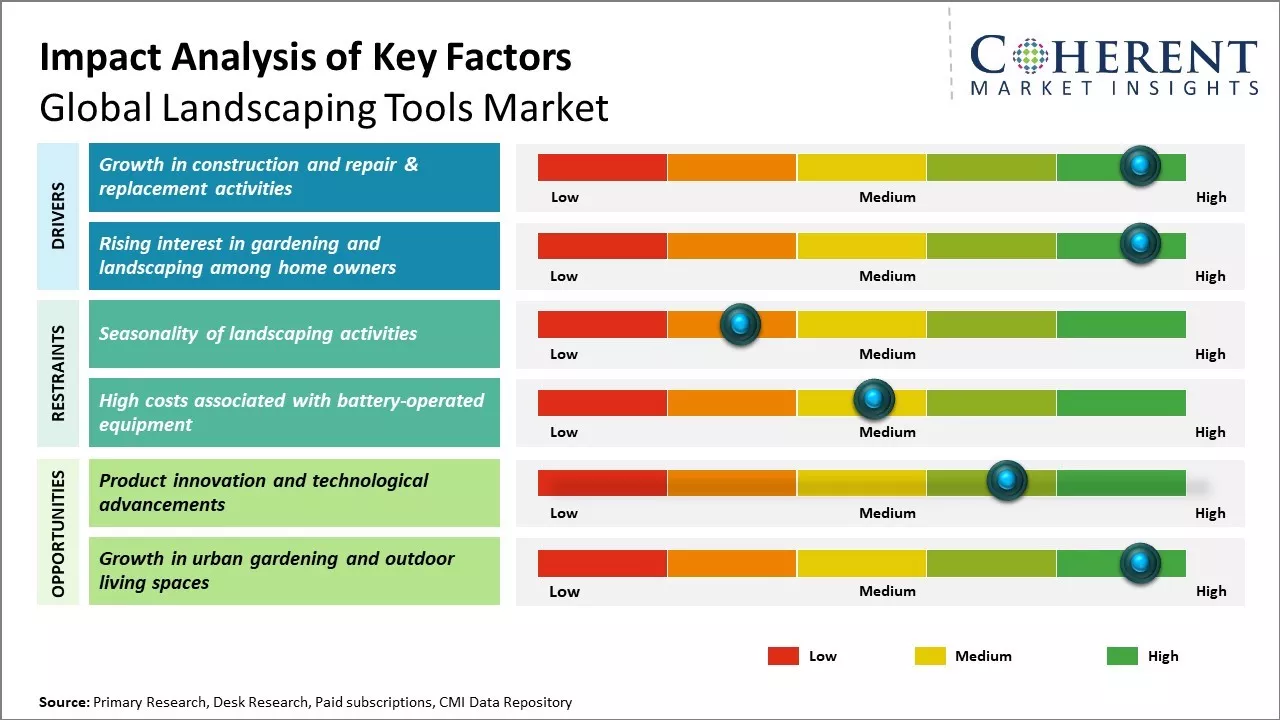
Landscaping tools market is estimated to be valued at USD 34.91 Bn in 2025 and is expected to reach USD 49.15 Bn in 2032, exhibiting a compound annual growth rate (CAGR) of 5% from 2025 to 2032.

To learn more about this report, Download Free Sample
The global landscaping tools market size is fueled by an increase in the building of residential and commercial real estate, urbanization, and disposable incomes, which increases spending on landscaping and home renovation. Rising commercial and residential property construction, urbanization, and an increased emphasis on environmental sustainability are driving the continuous rise of the worldwide landscaping tools market. The need for power and hand tools, technical developments like robotic lawnmowers, and a move toward environmentally friendly gardening techniques are driving the fastest-growing market in Europe.
For instance, in July 2024, Google introduced Agricultural Landscape Understanding (ALU) tool to provide agricultural information to farmers and boost crop yields. It is a limited availability tool aimed at making agricultural practices data-driven.
|
Event |
Description and Impact |
|
Growth in Construction & Urbanization |
|
|
Adoption of AI and Machine Learning in Automation |
|
Uncover macros and micros vetted on 75+ parameters: Get instant access to report
- Shovels and Spades: Entry-level models from brands like True Temper ($15-25), mid-range Fiskars ($25-40), and premium Garrett Wade ($45-75)
- Pruning Shears: Budget options from Corona ($12-20), professional-grade Felco ($35-65), and premium Japanese brands like ARS ($50-120)
- Rakes: Basic steel rakes ($8-15), ergonomic designs from Ames ($20-35), and specialized leaf rakes from Bully Tools ($25-45)
- Hand Weeders: Simple models ($5-12), ergonomic designs from Radius Garden ($15-25), and stainless-steel options from Sneeboer ($40-80)
- Hedge Shears: Basic models from Tabor Tools ($15-30), professional Bahco ($45-75), and premium Okatsune ($80-150)
- Loppers: Entry-level Corona ($20-35), mid-range Fiskars PowerGear ($40-60), and professional Silky ($70-120)
- Soil Augers: Manual post-hole diggers ($25-50), specialized planting augers ($60-120)
Lawn mowers segment is expected to dominate the landscaping tools market, accounting for 33.3% share in 2025 owing to the growing demand for well-maintained lawns and gardens across both the commercial and residential sectors. The rising affluence as well as awareness about green surroundings have compelled homeowners and commercial property owners to invest more in caring for their lawns and gardens. As a result, there has been significant growth in DIY lawn care activities as well as professional lawn care services over the past decade.
Lawn mowers offer effective and efficient solutions for cutting grass to the desired length and maintaining a manicured look of lawns. Their self-propelled and cordless variants have further boosted their popularity as they are easy to operate and maintain compared to traditional push mowers. In addition, robotic lawn mowers have emerged as a lucrative segment within the overall lawn mowers category owing to maximum automation with minimum human supervision needed.
The easy availability of varied types of lawn mowers suitable for small, medium and large gardens along with lucrative offers such as financing and discounts from retailers have augmented their sales. Moreover, constant innovation led by key players to introduce advanced features such as intelligent cutting systems, eco-friendly fuel types and compact designs have augmented the adoption of lawn mowers.
Overall, driven by the rising consumer preference for manicured and high-maintenance lawns, demand for reliable and efficient lawn mowing equipment like various types of lawn mowers continues to surge. This positions lawn mowers as the dominant category within the overall landscaping tools market.
The offline segment, which includes sales through specialty stores, mass merchandisers, hardware stores, and authorized dealers, is expected to contribute 72.6% of the market share in 2025 to the global landscaping tools market.
Shoppers still prefer touching, feeling and testing out landscaping equipment such as lawnmowers, trimmers and chainsaws in person before buying. Being able to consult store staff and receive guidance on right sizing and suitable tools for their need’s influences offline purchase decisions. Many also find it reassuring to buy larger and expensive garden equipment from established stores which offer assembly, repairs and maintenance support over the product lifetime.
Consumers also prefer buying consumables like lawnmower blades, trimmer Line and fuel from physical stores on an immediate "need" basis rather than wait for online delivery. Promotional schemes run by retailers along with lucrative discounts on tool bundles and packages also attract buyers to stores. The availability of specialized stores as well as relevant departments in hardware chains across most urban and suburban locations ensure easy access and convenience for landscaping product shopping.
While online shopping for landscaping tools is growing steadily, the immediate satisfaction of offline shopping along with value-added services will continue supporting the brick-and-mortar channels' dominance over the market in the foreseeable future.
In the landscaping tools market, the residential segment is projected to lead with a substantial market share of 65.4% in 2025. This dominance reflects the growing trend of homeowners investing in outdoor beautification and maintenance, driven by a rising emphasis on curb appeal and personal outdoor spaces. The increasing popularity of DIY landscaping projects and home improvement activities has significantly contributed to the demand for residential landscaping tools.
Consumers are seeking versatile, user-friendly, and efficient tools to enhance their garden and yard care routines. Additionally, advancements in technology and the availability of innovative, eco-friendly products have further fueled the growth of this segment. As homeowners continue to prioritize outdoor aesthetics and functionality, the residential sector's robust performance is expected to shape the overall dynamics of the landscaping tools market in the coming years.

To learn more about this report, Download Free Sample
North America has established itself as the dominant player in the global landscaping tools market. The region is expected to account for 35.7% share of the market in 2025. This can be attributed to several favourable factors driving market growth in the region. The U.S. accounts for the largest share primarily due to high consumer spending capabilities and awareness towards lawn and garden care.
Homeowners in the country take pride in maintaining lush green lawns and beautiful flower beds around their properties. This has fueled the demand for versatile landscaping tools from major brands for various tasks like mowing, edging, trimming, and gardening.
A well-established distribution network of hardware stores and dedicated garden centers provide customers with easy access to wide assortment of landscaping tools. Presence of leading manufacturers like Husqvarna, Stanley Black & Decker and MTD Products in the region further strengthens product availability. These companies continuously invest in new product development and technology to cater evolving consumer preferences. The region also benefits from short lead times and flexible inventory management due to concentrated manufacturing base.
The landscaping tools market in the Asia Pacific region has been witnessing rapid growth led by countries like China, Japan, and India. While countries like China and Japan have fairly developed markets, the potential in other developing nations is attracting major international players. With rising disposable incomes, more homeowners are willing to invest in their outdoor living spaces. This has accelerated the demand for quality landscaping tools at affordable prices in the region.
Export-oriented manufacturing policies and availability of low-cost labor in China have made it a dominant sourcing destination for landscaping tools. On the other hand, countries like India offer huge untapped market opportunities with increasing urbanization and construction activities.
Leading companies have started focusing on this region by establishing local manufacturing plants and strengthening distribution networks to capitalize on future prospects. The Asia Pacific region promises huge gains and its market dynamics will be interesting to watch in the coming years.
The market is supported by increasing consumer interest in sustainable gardening, eco-friendly tools, and the convenience of online purchasing. Key trends include a shift toward compact and space-saving tools due to urbanization and the popularity of smaller gardens, especially as more people move to cities.
The U.S. leads the world market for landscaping products because of its extensive residential and commercial building projects, high levels of disposable money, and robust outdoor living and home renovation cultures. Both DIY homeowners and professional landscapers are driving a strong demand for cutting-edge landscaping equipment, including intelligent and environmentally friendly tools.
Smart gardening technologies like sensor-based irrigation systems, app-connected gadgets, and automated lawn mowers are becoming more and more popular, particularly in cities where efficiency and convenience are top concerns. India is positioned as a rapidly developing market for creative landscaping solutions due to the tendency toward sustainable and do-it-yourself gardening and technical improvements.
China is a leading force in the landscaping tools market, supported by rapid urbanization, large-scale infrastructure projects, and a growing middle class with rising interest in home and garden improvement. The country’s focus on green city initiatives and environmental sustainability has driven demand for both traditional and smart landscaping equipment.
| Report Coverage | Details | ||
|---|---|---|---|
| Base Year: | 2024 | Market Size in 2025: | USD 34.91 Bn |
| Historical Data for: | 2020 To 2024 | Forecast Period: | 2025 To 2032 |
| Forecast Period 2025 to 2032 CAGR: | 5% | 2032 Value Projection: | USD 49.15 Bn |
| Geographies covered: |
|
||
| Segments covered: |
|
||
| Companies covered: |
Bosch, Caterpillar Inc., DeWalt, Echo, Husqvarna, John Deere, Kubota, Makita, MTD Products, Oregon, STIHL, Toro, TruCut, Worx, and Yamaha |
||
| Growth Drivers: |
|
||
| Restraints & Challenges: |
|
||
Uncover macros and micros vetted on 75+ parameters: Get instant access to report

To learn more about this report, Download Free Sample
The global construction industry has been witnessing steady growth over the past few years and this momentum is expected to continue going forward. Rising population levels, increasing urbanization, higher infrastructure spending by various governments, and growth in commercial and residential construction projects are some of the major factors fueling demand for construction activities worldwide. The repair and renovation market are also growing at a healthy pace supported by the aging infrastructure in developed nations and the increasing disposable incomes that are allowing homeowners to invest more in home improvement projects.
All these construction and repair/replacement activities create a huge demand for various landscaping tools. Whether it is a large commercial construction of a shopping mall, apartment complex or an office building, or remodeling an existing home or a small renovation project, landscaping plays an important role in the overall design and aesthetics.
Professional landscaping contractors and gardeners require a wide range of tools from lawnmowers, hedge trimmers to shovel and wheelbarrows to efficiently manage the surrounding landscaping for any construction project. Additionally, growing environmental concerns have also increased focus on using native plants, trees, and shrubs in construction landscaping, thereby driving tool requirements.
Similarly, the repair and remodeling market is a key source of steady demand for landscaping tools. As properties age, homeowners and contractors undertake repair works that often involve overhaul of the existing landscape layout, planting new bushes/trees, repairing walkways or patios. This stimulates demand for a variety of tools from pruners, loppers to saws. Majority of homeowners also prefer to conduct routine backyard maintenance work themselves which keeps the recurring demand healthy for small engine powered landscaping tools.
Additionally, better quality durable tools also encourage replacement/upgrade purchases over time. With construction and repair/remodeling activities projected to continue its momentum in the coming years, it will keep supporting demand for landscaping tools globally.
In today's stressful urban lifestyle, more and more homeowners are finding gardening and landscaping as a means to relief stress and also elevate the aesthetics of their living space. What was once just considered a chore, landscaping is today emerging as a serious hobby and interest for many home owners. The growing availability of information on gardening and landscaping through various digital media platforms has also raised awareness about the benefits of green landscaping.
This rising passion for gardening is driving steady sales of both hand tools such as pruners, shovels, yard rakes as well as powered equipment including lawnmowers, hedge trimmers, and leaf blowers. Homeowners with large yards and gardens now view landscaping equipment not just as tools but as necessary household appliances to efficiently maintain their outdoor spaces. The convenience and ease of modern landscaping tools have made yard work much less daunting for amateur gardeners. Meanwhile, the health and stress relief benefits of working outdoors in one's garden are also attracting more participants.
Growing environmental consciousness is another key factor triggering interest in landscaping for a beautiful, green outdoor space. Homeowners now prefer using native plant species, establishing vegetable gardens, creating wildlife habitats using landscaping. This trend necessitates tools for tasks like demolition, soil preparation, hedge shaping, leaf cleanup etc. Garden centers and online retailers capitalize on this enthusiasm by offering wide products tailored for every budget and skill level. Tools specifically marketed for women gardeners are also gaining popularity.
Rising construction of commercial and residential properties, along with increasing urbanization, is fueling demand for landscaping tools for both new projects and renovation activities.
The global landscaping tools market presents considerable opportunities for players willing to focus on product innovation and adoption of new technologies. With rising consumer demand for high performance, convenient, and smart products, manufacturers have a scope to develop advanced tools that address current pain points. For instance, introducing landscaping tools with ergonomic designs can help reduce physical strain during long use. Integrating technologies like lithium-ion batteries can boost power, endurance, and ease of use. Connected equipment with sensors and IoT enabled features have potential to optimize performance and facilitate data-driven maintenance. Market leaders can gain competitive edge by developing sustainable products with safer, durable and eco-friendly materials. Partnerships with landscape service providers create openings for subscription-based, fleet management business models as well. Overall, innovative products catering to evolving consumer preferences open new revenue streams in this market.
*Definition: The global landscaping tools market consists of various tools and equipment that are used for maintaining residential and commercial landscapes. This includes tools for digging and cultivation like shovels, forks, and trowels. It also comprises of tools for cutting and trimming grass and plants such as lawn mowers, hedge trimmers, and pruning shears. Other tools involve in this market are wheelbarrows, rakes, brooms for clearing debris and hauling materials.
Share
Share
About Author
Ramprasad Bhute is a Senior Research Consultant with over 6 years of experience in market research and business consulting. He manages consulting and market research projects centered on go-to-market strategy, opportunity analysis, competitive landscape, and market size estimation and forecasting. He also advises clients on identifying and targeting absolute opportunities to penetrate untapped markets.
Missing comfort of reading report in your local language? Find your preferred language :
Transform your Strategy with Exclusive Trending Reports :
Frequently Asked Questions
Joining thousands of companies around the world committed to making the Excellent Business Solutions.
View All Our Clients